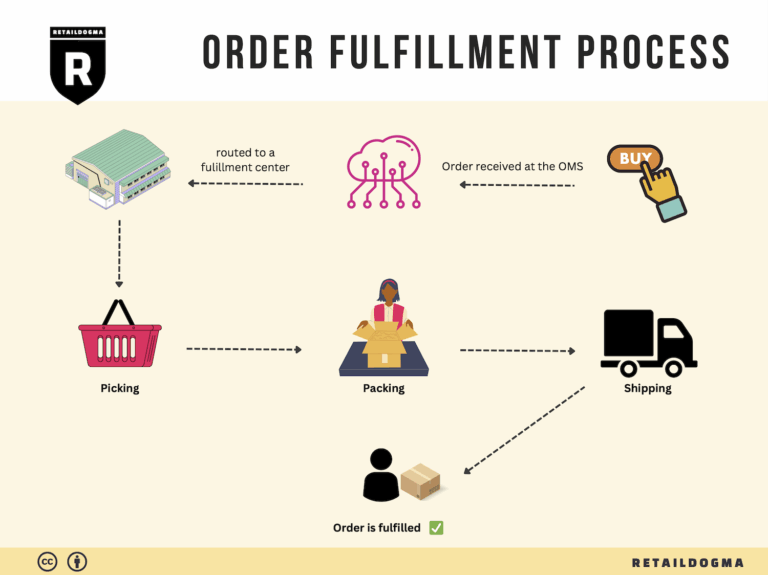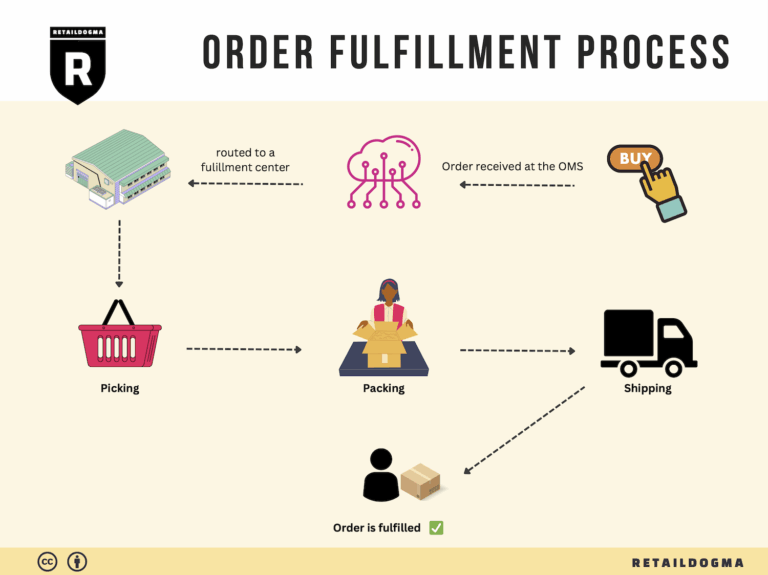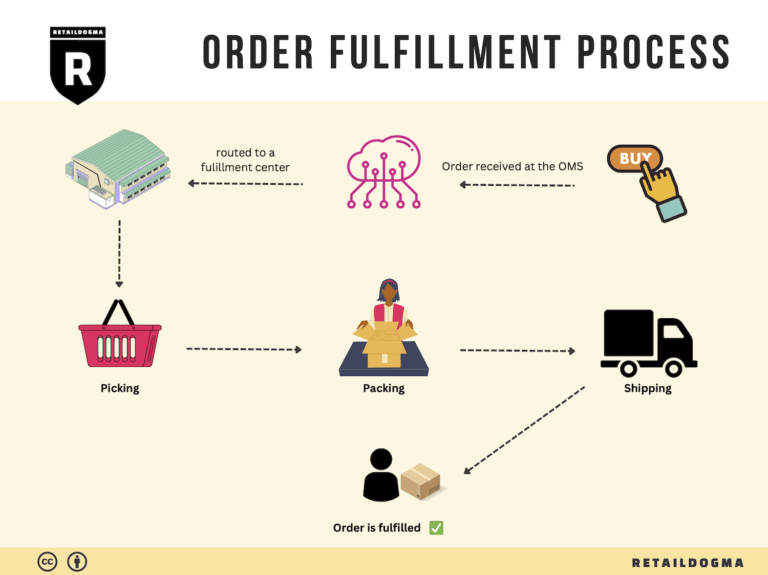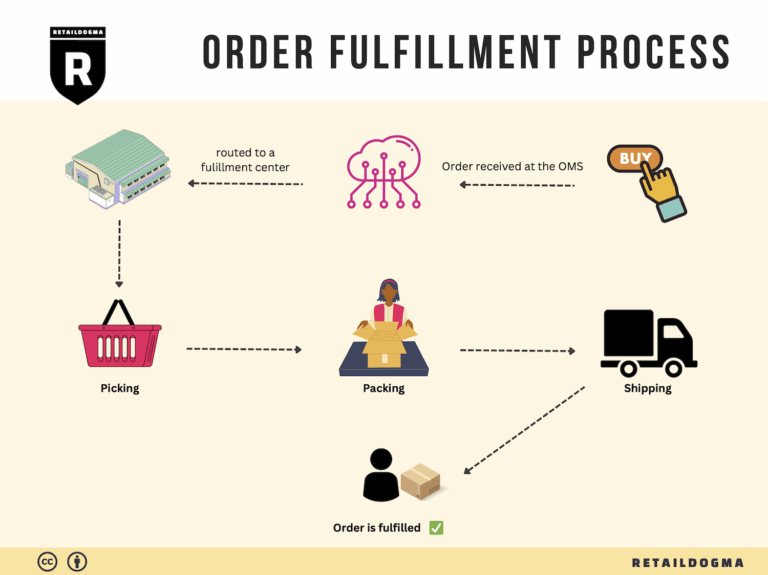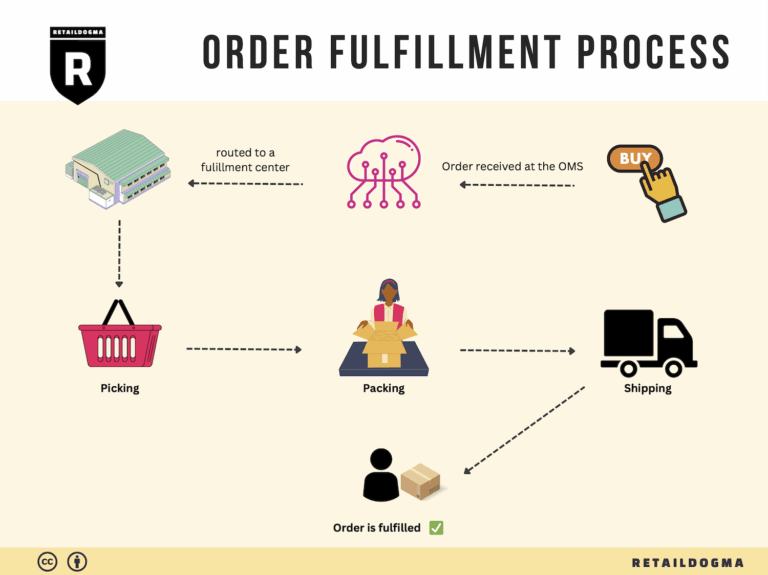Ecommerce Fulfillment Services: The Ultimate Guide (2025)
What is E-commerce Fulfillment? An Introduction for Growing Businesses
Understanding E-commerce Fulfillment
As your e-commerce business grows, the excitement of increased sales can quickly turn into the stress of managing packing and shipping orders. Many entrepreneurs find themselves overwhelmed by the logistics involved in delivering products to customers on time and in good condition. This is where e-commerce fulfillment comes into play. Simply put, fulfillment is the process of getting a product from your inventory to your customer’s doorstep, encompassing everything from storage to shipping and handling returns.
In this guide, we will delve into the various models of e-commerce fulfillment that can help you scale your operations effectively. You will learn about options like Third-Party Logistics (3PL) providers and Amazon’s Fulfillment by Amazon (FBA) program, both of which offer distinct advantages depending on your business needs. Understanding these models is crucial for making informed decisions about your logistics strategy.
We will also explore core fulfillment services, which include inventory management, order processing, packaging, shipping, and customer service. Each of these components plays a vital role in ensuring that your customers receive their orders accurately and promptly. By mastering these areas, you can enhance customer satisfaction and encourage repeat business.
Choosing the right fulfillment partner is another critical aspect we will cover. The selection process involves evaluating potential partners based on their technology, scalability, geographical reach, and pricing structures. It’s essential to find a partner who aligns with your business goals and can support your growth trajectory.
Pricing models for fulfillment services can vary widely, influenced by factors such as order volume, product size, and service levels. We will break down the typical costs associated with fulfillment, helping you understand how to budget and plan for these expenses as you expand.
The goal of this guide is to empower you to make smart, strategic decisions about your logistics. By understanding the intricacies of e-commerce fulfillment, you can streamline your operations, improve customer experiences, and ultimately drive your business’s success. Let’s embark on this journey to demystify fulfillment and set your e-commerce business up for sustainable growth.

What You’ll Learn In This Guide
- What is E-commerce Fulfillment? An Introduction for Growing Businesses
- The Order Fulfillment Process: From ‘Buy’ Button to Customer’s Door
- Comparing Fulfillment Models: In-House vs. 3PL vs. Dropshipping
- A Deep Dive into Amazon FBA: Pros, Cons, and Who It’s For
- Core Services Offered by Fulfillment Centers
- How to Choose a Fulfillment Partner: A 6-Point Checklist
- Understanding Fulfillment Pricing: A Breakdown of Common Fees
- Frequently Asked Questions (FAQs) about Fulfillment
- Conclusion: Is Outsourcing Fulfillment the Right Move for Your Business?
- Important Disclaimer
The Order Fulfillment Process: From ‘Buy’ Button to Customer’s Door
1. Receiving Inventory
The first step in the order fulfillment process is receiving inventory. This involves the arrival of products at the fulfillment center, where they are checked against purchase orders to ensure accuracy. Key personnel will inspect the items for quality and damage, and then record the inventory into the system using Stock Keeping Units (SKUs).
Importance: Accurate inventory receiving is crucial as it establishes the foundation for effective order fulfillment. Errors at this stage can lead to stock discrepancies, which may result in delayed orders or customer dissatisfaction. Efficient receiving processes can also streamline the entire workflow, reducing the time spent on future steps.
Key Term: SKU (Stock Keeping Unit) – A unique identifier for each product that aids in inventory tracking.
2. Warehouse Storage
Once the inventory is received and verified, the next step is warehouse storage. Products are organized and placed in designated storage areas within the fulfillment center. This organization can follow various methods, such as random storage or fixed storage, depending on the facility’s design and the type of products handled.
Importance: Proper warehouse storage optimizes space and enhances the efficiency of order fulfillment. An organized warehouse minimizes the time it takes to locate items, which is essential for quick order processing. Additionally, effective storage solutions can improve inventory management, making it easier to keep track of stock levels and perform audits.
Key Term: ABC Analysis – A method of categorizing inventory based on importance and value, helping prioritize storage locations.
3. Order Picking
The third step is order picking, where items are retrieved from storage to fulfill customer orders. This process can be carried out using various picking methods, including batch picking, wave picking, or zone picking, depending on the volume and type of orders being processed.

Importance: Efficient order picking is critical for meeting delivery timelines. The faster and more accurately items can be picked, the quicker they can be packed and shipped. A well-designed picking process reduces labor costs and minimizes errors, ultimately enhancing customer satisfaction.
Key Term: Pick List – A document or digital order that outlines the items and quantities to be picked for fulfilling a specific order.
4. Order Packing
After the items are picked, they move to the packing stage. Here, items are carefully packaged to ensure they arrive at the customer’s doorstep in perfect condition. This may involve selecting appropriate packing materials, such as boxes, bubble wrap, or packing peanuts, and labeling the package for shipment.
Importance: Effective packing not only protects the products during transit but also reflects the brand’s commitment to quality. Proper packing can reduce return rates due to damage, and thoughtful packaging can enhance the customer experience, potentially leading to repeat business.
Key Term: Packing Slip – A document included with the shipment that lists the items in the package, serving as a receipt for the customer.
5. Shipping & Delivery
The final step in the fulfillment process is shipping and delivery. Once packages are packed, they are scheduled for shipment through various carriers. Fulfillment centers like Amazon’s AKR1 utilize advanced logistics networks to ensure timely delivery to customers. This includes selecting the most efficient shipping methods based on factors like destination, package size, and delivery speed.
Importance: The shipping and delivery stage is the culmination of the entire fulfillment process. Timely delivery is a significant factor in customer satisfaction and can influence future purchasing decisions. A well-executed shipping strategy can also reduce costs and improve operational efficiency.
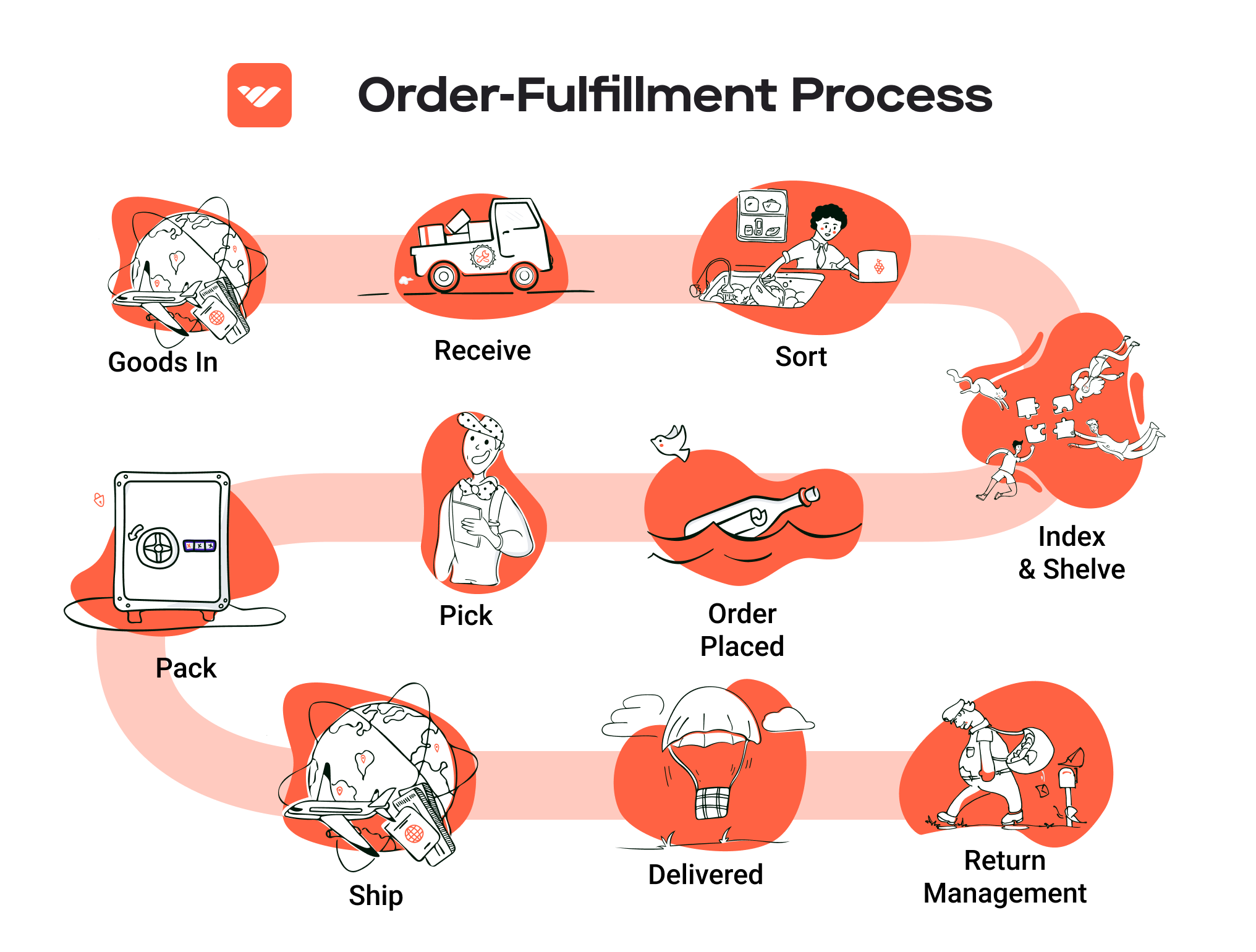
Key Term: Last-Mile Delivery – The final step in the delivery process where the package is transported from a distribution center to the end customer, often considered the most critical and expensive part of the shipping process.
By understanding and optimizing each step in the order fulfillment process, e-commerce business owners and operations managers can enhance their logistics capabilities, improve customer satisfaction, and ultimately scale their operations effectively.
Comparing Fulfillment Models: In-House vs. 3PL vs. Dropshipping
Fulfillment Model Comparison Table
| Model | Who Handles Inventory | Best For (Business Stage) | Key Advantage | Key Disadvantage |
|---|---|---|---|---|
| In-House Fulfillment | The business itself | Established businesses | Full control over inventory and processes | High overhead costs and complexity |
| Third-Party Logistics (3PL) | A specialized logistics provider | Growing businesses | Scalability and access to expertise | Less control over inventory and potential delays |
| Dropshipping | Supplier or manufacturer | Startups or small businesses | Low upfront investment and minimal risk | Lower profit margins and dependency on suppliers |
In-House Fulfillment
In-house fulfillment involves managing all aspects of inventory, warehousing, and shipping operations within the business itself. This model is typically adopted by established businesses that have reached a scale where they can justify the costs associated with running their own fulfillment operations. The primary advantage of in-house fulfillment is the level of control it provides over the entire process. Businesses can tailor their warehousing setup, inventory management, and shipping protocols to meet their specific needs and customer expectations. This can result in improved customer service and faster shipping times, as the business can directly manage its logistics.
However, this model comes with significant drawbacks. The overhead costs can be substantial, including expenses related to warehouse space, staffing, equipment, and technology. Additionally, managing fulfillment in-house can complicate operations, requiring expertise in logistics and supply chain management that may not be readily available within the organization. This complexity can be particularly challenging during peak seasons or periods of growth, when the demands on the fulfillment operation can increase dramatically.
Third-Party Logistics (3PL)
Third-party logistics (3PL) involves outsourcing fulfillment operations to a specialized logistics provider. This model is particularly beneficial for growing businesses that need to scale their operations without the upfront investment in infrastructure. A 3PL provider manages inventory, warehousing, and shipping, allowing businesses to focus on other core activities such as marketing and product development. The key advantage of this model is scalability; businesses can easily adjust their logistics needs based on demand fluctuations without incurring significant costs or risks.
Moreover, 3PL providers often come with expertise in logistics, technology, and compliance, which can enhance efficiency and reliability. However, one of the main disadvantages is the reduced control over inventory and shipping processes. Businesses must rely on their 3PL partner to meet service level agreements, which can lead to potential delays or errors that impact customer satisfaction. Additionally, the costs associated with 3PL services can vary, and businesses must carefully evaluate contracts to ensure they align with their financial goals.
Dropshipping
Dropshipping is a fulfillment model where the retailer does not keep products in stock but instead transfers customer orders directly to a supplier or manufacturer, who then ships the products directly to the customer. This model is particularly appealing to startups and small businesses due to its low upfront investment and minimal risk. Since there is no need to invest in inventory or warehouse space, entrepreneurs can focus on marketing and customer acquisition without the burden of managing stock.
The primary advantage of dropshipping is the flexibility it offers; businesses can experiment with a wide range of products without significant financial commitment. However, this model also has notable disadvantages. Profit margins are often lower compared to other fulfillment methods because the retailer must pay the supplier’s price, which typically includes a markup. Additionally, dropshipping relies heavily on suppliers for inventory management and shipping, which can lead to issues with order fulfillment, product quality, and delivery times. Any delays or errors on the supplier’s part can directly impact the retailer’s reputation and customer satisfaction.
Conclusion
In summary, each fulfillment model presents unique advantages and challenges. In-house fulfillment is ideal for established businesses that require complete control and can manage the associated costs. Third-party logistics (3PL) offers a scalable solution for growing companies seeking expertise and flexibility without the overhead of managing fulfillment directly. Lastly, dropshipping provides a low-risk entry point for startups but comes with challenges related to profit margins and supplier reliability. Understanding these models and aligning them with your business goals is crucial for optimizing your e-commerce logistics strategy.
A Deep Dive into Amazon FBA: Pros, Cons, and Who It’s For
Understanding Fulfillment by Amazon (FBA)
Fulfillment by Amazon (FBA) is a service provided by Amazon that allows e-commerce sellers to store their products in Amazon’s fulfillment centers. When a customer orders a product, Amazon takes care of storage, packaging, and shipping, as well as handling customer service and returns. This service is designed to simplify the logistics for sellers, allowing them to scale their businesses without the overhead of managing their own fulfillment operations.
How FBA Works
-
Product Preparation: Sellers send their products to Amazon’s fulfillment centers. Each product must be properly prepared and labeled according to Amazon’s guidelines to ensure smooth processing.
-
Storage: Once received, products are stored in Amazon’s warehouses. Sellers are charged for storage space based on the volume of their products.
-
Order Fulfillment: When a customer places an order, Amazon picks, packs, and ships the product directly to the customer. This process leverages Amazon’s extensive logistics network to ensure fast delivery.
-
Customer Service and Returns: Amazon also handles customer inquiries and returns for FBA products, which can enhance the customer experience and reduce the seller’s workload.
-
Reporting and Analytics: Sellers have access to tools that help them track inventory levels, sales performance, and customer feedback, allowing for data-driven decision-making.
Pros of Fulfillment by Amazon (FBA)
-
Prime Eligibility: Products fulfilled through FBA are eligible for Amazon Prime. This increases visibility and sales potential, as Prime members often prefer Prime-eligible products due to faster shipping.
-
Customer Trust: Amazon’s reputable brand enhances customer confidence. Buyers are more likely to purchase from a seller using FBA, knowing that Amazon backs the fulfillment process.
-
Multi-Channel Fulfillment: FBA can be used to fulfill orders from other sales channels, such as eBay, Shopify, or a seller’s own website. This capability allows businesses to streamline their fulfillment processes across multiple platforms.
-
Scalability: FBA enables sellers to scale their operations quickly without needing to invest heavily in their own warehousing and logistics. As sales grow, sellers can easily send more inventory to Amazon.
-
Time Savings: By outsourcing fulfillment to Amazon, sellers can focus more on marketing and growing their business rather than managing logistics and customer service.
Cons of Fulfillment by Amazon (FBA)
-
High Fees: FBA comes with various fees, including storage fees and fulfillment fees. These can accumulate quickly, particularly for slow-moving inventory, which can impact profit margins.
-
Strict Inventory Rules: Amazon has specific guidelines regarding inventory management, including limits on certain categories and requirements for labeling and packaging. Sellers must comply with these rules to avoid penalties.
-
Commingling Risks: FBA products can be commingled with similar products from other sellers, which may lead to issues if a customer receives a defective or counterfeit item. This can affect seller ratings and trust.
-
Loss of Control: When using FBA, sellers relinquish some control over the fulfillment process. This includes packaging and shipping methods, which might not align with a seller’s brand image.
-
Long-Term Storage Fees: If inventory does not sell within a certain timeframe, Amazon imposes long-term storage fees, which can significantly affect profitability.
Who is FBA Best For?
Fulfillment by Amazon is particularly well-suited for:
-
E-commerce Entrepreneurs: Those just starting out or scaling their business who want to leverage Amazon’s logistics without investing in their own infrastructure.
-
High-Volume Sellers: Businesses that have a steady flow of sales and can benefit from the efficiencies of Amazon’s fulfillment network.
-
Sellers of Large or Bulky Items: Given that Amazon’s fulfillment centers, like the new AKR1 facility in Canton, are equipped to handle bulky products, sellers in this niche can benefit significantly from FBA.
-
Brands Looking for Trust: Companies seeking to enhance their credibility and gain the trust of Amazon’s customer base can leverage FBA to improve their market presence.
-
Multi-Channel Retailers: Those who sell on multiple platforms and want a unified fulfillment solution can utilize FBA to streamline their operations.
In conclusion, Fulfillment by Amazon offers a powerful solution for many e-commerce sellers looking to scale their operations. By weighing the pros and cons and assessing their specific business needs, sellers can determine if FBA is the right fit for their logistics strategy.
Core Services Offered by Fulfillment Centers
Inventory Management & Warehousing
Inventory management and warehousing are foundational services provided by fulfillment centers. This involves the systematic tracking of goods as they are received, stored, and dispatched. Fulfillment centers utilize advanced inventory management systems that integrate real-time data to monitor stock levels, manage reorders, and optimize storage space.
Benefits:
1. Efficiency in Operations: With a robust inventory management system, e-commerce businesses can minimize overstock and stockouts, ensuring they meet customer demand without incurring unnecessary holding costs.
2. Data-Driven Decisions: Access to real-time inventory data allows business owners to make informed decisions regarding purchasing and inventory levels, leading to improved cash flow management.
3. Space Optimization: Fulfillment centers are designed to maximize storage efficiency, which is particularly beneficial for businesses with limited warehouse space. By leveraging these facilities, e-commerce businesses can focus on scaling their operations without the burden of physical storage constraints.
Pick and Pack Services
Pick and pack services refer to the process of retrieving ordered items from the warehouse (picking) and preparing them for shipment (packing). Fulfillment centers employ trained staff and automated systems to streamline this process, ensuring that orders are accurately fulfilled and dispatched quickly.
Benefits:
1. Speed and Accuracy: Fulfillment centers can process orders faster than most in-house operations due to their specialized systems and trained personnel. This leads to quicker delivery times, enhancing customer satisfaction and loyalty.
2. Scalability: As e-commerce businesses grow, their order volumes can fluctuate significantly. Fulfillment centers provide the flexibility to scale operations up or down based on demand without the need to hire additional staff or invest in infrastructure.
3. Error Reduction: Automated picking systems and experienced staff reduce the likelihood of errors in order fulfillment, which can lead to costly returns and dissatisfied customers.
Kitting and Assembly
Kitting and assembly services involve combining multiple products into a single package or kit, making it easier for customers to purchase related items together. This service is particularly useful for businesses that sell products that are often used in conjunction with one another, such as a grill with grilling accessories.
Benefits:
1. Enhanced Customer Experience: Offering products in kits can simplify the purchasing process for customers, making it more likely they will buy multiple items at once. This can lead to increased average order value.
2. Customizability: Kitting services allow businesses to create unique product bundles tailored to specific customer needs or seasonal promotions, which can differentiate them from competitors.
3. Operational Efficiency: By outsourcing kitting and assembly, businesses can streamline their supply chain operations, focusing their resources on core competencies like marketing and customer service.
Returns Management (Reverse Logistics)
Returns management, or reverse logistics, is the process of handling returned items efficiently and effectively. Fulfillment centers manage this complex process by inspecting returned products, restocking items, and processing refunds or exchanges.
Benefits:
1. Streamlined Returns Process: A well-managed returns process can significantly enhance customer satisfaction. Fulfillment centers handle returns quickly and efficiently, allowing customers to receive refunds or exchanges in a timely manner.
2. Cost Control: By optimizing the returns process, fulfillment centers can minimize losses associated with returns. This includes assessing the condition of returned items and determining whether they can be resold, refurbished, or need to be disposed of.
3. Data Insights: Analyzing returns data can provide valuable insights into product performance and customer preferences. Businesses can use this information to make informed decisions about inventory management, product offerings, and marketing strategies.
In conclusion, leveraging the core services offered by fulfillment centers can significantly enhance the efficiency and effectiveness of an e-commerce operation. By outsourcing inventory management, pick and pack services, kitting, and returns management, businesses can focus on growth and customer satisfaction while benefiting from the expertise and infrastructure of specialized fulfillment partners. This strategic approach not only improves operational efficiency but also positions businesses to scale effectively in a competitive marketplace.
How to Choose a Fulfillment Partner: A 6-Point Checklist
Location & Warehouse Network
When selecting a fulfillment partner, the geographical location of their warehouses can significantly impact your logistics efficiency. A well-placed fulfillment center reduces shipping times and costs, improving customer satisfaction.
Key Questions to Ask:
– Where are your fulfillment centers located, and how does this network align with my target customer base?
– What is the average shipping time to my primary markets?
– Do you have facilities that can handle both local and international shipping needs?
Technology & Integrations
In today’s digital landscape, the technology used by your fulfillment partner is crucial. Look for partners that utilize advanced logistics software and automation to streamline operations, track inventory in real-time, and provide insights into order fulfillment processes.
Key Questions to Ask:
– What technology platforms do you use for inventory management, order tracking, and reporting?
– How do you integrate with e-commerce platforms (like Shopify, Amazon, or eBay) and other systems (like ERPs)?
– Do you offer APIs for real-time data exchange, and how user-friendly is your dashboard for tracking shipments?
Specializations (e.g., Cold Storage, Oversized Items)
Depending on your product range, you may need a fulfillment partner with specific capabilities. If you sell perishable goods, for instance, cold storage is essential. If your products are bulky or oversized, ensure the partner can accommodate those logistics.
Key Questions to Ask:
– What types of products do you specialize in handling?
– Do you have facilities equipped for special storage needs (e.g., temperature-controlled environments)?
– Can you handle custom packaging or special handling for fragile items?
Scalability & Capacity
As your business grows, so will your logistics needs. Choose a fulfillment partner that can scale operations efficiently. They should have the capacity to handle peak seasons and the flexibility to adapt to changing demands without compromising service quality.
Key Questions to Ask:
– How do you manage fluctuations in order volume during peak seasons?
– What is your process for onboarding new clients and scaling operations?
– Can you provide examples of how you’ve successfully managed growth for other clients?
Pricing and Contracts
Understanding the pricing structure and contract terms is vital to maintaining profitability. Look for transparency in costs, including storage fees, shipping rates, and any additional charges for special services.
Key Questions to Ask:
– Can you provide a detailed breakdown of your pricing model?
– Are there any hidden fees that I should be aware of?
– What are the terms for contract length, and what is your policy for contract termination?
Customer Support & Reviews
Exceptional customer support can differentiate a good fulfillment partner from a great one. Investigate their reputation through customer reviews and ensure they have a responsive support system in place.
Key Questions to Ask:
– What is your customer support structure? Is there a dedicated account manager?
– How quickly can I expect responses to inquiries or issues?
– Can you provide references or case studies from current or past clients?
Conclusion
Choosing the right fulfillment partner is a critical step in scaling your e-commerce business. By utilizing this checklist, you can evaluate potential partners comprehensively, ensuring they align with your operational needs and growth objectives. Remember, the goal is to enhance your logistics capabilities while maintaining a focus on customer satisfaction and cost-effectiveness.
Understanding Fulfillment Pricing: A Breakdown of Common Fees
Initial Setup Fees
When partnering with a fulfillment center like Amazon’s AKR1, businesses often encounter initial setup fees. These are one-time costs incurred to establish your account and integrate your inventory into the fulfillment system. The setup process may include creating your seller account, configuring your shipping settings, and entering product details into the system.
Calculation: Initial setup fees typically depend on the complexity of the integration required. This could range from a few hundred to several thousand dollars based on the number of products and the level of customization needed. It’s essential to inquire about all potential costs upfront to avoid unexpected expenses.
Receiving Fees
Receiving fees are charged when your products arrive at the fulfillment center. These fees cover the labor and resources necessary to unload, inspect, and store your inventory. For centers like AKR1, the efficiency of receiving can vary based on the volume of incoming goods and the specific handling requirements for your products.
Calculation: Generally, receiving fees are calculated per unit received or per pallet. For example, a center might charge $0.30 per item or $15 per pallet. Businesses should factor in how frequently they will be sending inventory to the fulfillment center to estimate these costs accurately.
Storage Fees (per pallet/bin)
Storage fees are charged for the space your inventory occupies in the fulfillment center. This can be particularly important for e-commerce businesses with large or bulky items, like those processed at AKR1, which specializes in larger goods.
Calculation: Storage fees are usually calculated on a monthly basis, either per pallet or per bin. For instance, a facility might charge $10 per pallet per month. Additionally, many fulfillment centers implement tiered pricing, where the cost per pallet decreases as the volume increases. Understanding the storage rates and the duration of inventory storage is crucial for managing your overall fulfillment costs.
Pick & Pack Fees (per item/order)
Pick & pack fees cover the labor involved in selecting items from the warehouse and packaging them for shipment. This fee is crucial for businesses that sell a variety of products, as it directly impacts fulfillment efficiency and customer satisfaction.
Calculation: These fees are typically charged per item or per order. For example, a fulfillment center may charge $1.00 per item picked and packed, or a flat fee of $3.00 per order regardless of the number of items. It’s important for businesses to analyze their average order size to estimate these costs accurately and explore options to optimize order fulfillment processes.
Shipping Fees
Shipping fees encompass the costs associated with delivering packages from the fulfillment center to customers. This is often one of the most significant components of fulfillment pricing and can vary greatly depending on factors such as package size, weight, destination, and the shipping carrier used.
Calculation: Shipping fees are typically calculated based on the weight and dimensions of the package, as well as the chosen shipping method (e.g., standard, expedited). Many fulfillment centers have partnerships with major carriers, allowing them to pass on discounted rates to their clients. Businesses should evaluate the shipping options available and consider negotiating rates based on their shipping volume.
Tips for Getting an Accurate Quote
-
Provide Detailed Information: When seeking a quote from a fulfillment center, provide detailed information about your products, including dimensions, weight, and the expected order volume. This will help them give a more accurate estimate.
-
Understand Your Needs: Clearly outline your fulfillment requirements, including storage needs, frequency of shipments, and seasonal fluctuations. This information will influence the pricing structure.
-
Request a Breakdown: Ask for a detailed breakdown of all fees associated with fulfillment services. Understanding each cost component will help you make informed decisions.
-
Compare Options: Don’t settle for the first quote. Compare multiple fulfillment centers to find one that offers the best combination of services, pricing, and reliability.
-
Consider Long-Term Contracts: If you expect to scale your business, consider negotiating long-term contracts that may offer lower rates or additional services at no extra cost.
By understanding these common fulfillment pricing models and following these tips, e-commerce businesses can effectively manage their logistics costs and optimize their operations for growth.
Frequently Asked Questions (FAQs) about Fulfillment
1. What is the Amazon Fulfillment Center AKR1?
The Amazon Fulfillment Center AKR1 is a state-of-the-art facility located in Canton, Ohio, covering 1 million square feet. It specializes in processing and delivering large or bulky items, such as patio furniture and rugs. This center began operations in May 2023 and is part of Amazon’s extensive network of fulfillment centers designed to enhance logistics efficiency.
2. What types of products are handled at AKR1?
AKR1 primarily focuses on large and non-sortable items. This includes bulky products that require special handling and packaging, such as furniture, home goods, and other oversized items. The center is equipped to ensure efficient storage, packing, and shipping of these products.
3. How does AKR1 differ from other Amazon fulfillment centers?
AKR1 is classified as a non-sortable fulfillment center, meaning it does not utilize advanced robotics for sorting like some of Amazon’s sortable facilities. Instead, it employs safety technology and mechanical handling equipment to manage the movement and processing of large items.
4. What are the employment opportunities at AKR1?
The fulfillment center employs around 1,000 people, with plans to hire approximately 125 new associates each month. Positions include fulfillment associates, management roles, and various support functions. Employees receive competitive wages starting at $19 per hour, along with comprehensive benefits.
5. How does Amazon ensure timely delivery from AKR1?
Amazon employs a well-structured logistics network that leverages advanced technology, efficient processing systems, and strategic location. The center’s design allows for streamlined operations, enabling quick order processing and dispatch, which is essential for meeting delivery promises to customers.
6. What is the difference between a warehouse and a fulfillment center?
A warehouse primarily serves as a storage space for goods, focusing on inventory management and bulk storage. In contrast, a fulfillment center is dedicated to processing customer orders, packing, and shipping products directly to consumers. Fulfillment centers are optimized for speed and efficiency in order fulfillment.
7. What is a Third-Party Logistics Provider (3PL)?
A Third-Party Logistics Provider (3PL) is a company that offers outsourced logistics services, including transportation, warehousing, and fulfillment. Businesses often partner with 3PLs to manage their supply chain, allowing them to focus on core activities while leveraging the expertise and resources of logistics specialists.
8. How much do fulfillment services cost?
The cost of fulfillment services can vary widely based on several factors, including the volume of orders, the type of products, and specific service requirements (e.g., packing, shipping, storage). Generally, costs may include per-order fees, storage fees, and shipping charges. It’s advisable to request quotes from multiple fulfillment providers to get a clear understanding of pricing.
9. What safety measures are in place at AKR1?
AKR1 implements various safety technologies and protocols to ensure a secure working environment for employees. This includes mechanical handling equipment designed with safety features, regular safety training for staff, and adherence to workplace health and safety standards.
10. How can businesses partner with AKR1 for fulfillment?
Businesses can partner with Amazon for fulfillment by enrolling in the Fulfillment by Amazon (FBA) program. This program allows sellers to store their products in Amazon’s fulfillment centers, where Amazon takes care of storage, packing, shipping, and customer service. Interested businesses should visit Amazon’s seller services website to learn more about enrollment and requirements.
Conclusion: Is Outsourcing Fulfillment the Right Move for Your Business?
Evaluating the Benefits of Outsourcing Fulfillment
Outsourcing fulfillment can be a transformative decision for e-commerce businesses aiming for growth. By leveraging the capabilities of a dedicated fulfillment partner, companies can unlock several key advantages that directly contribute to operational efficiency and customer satisfaction.
First and foremost, outsourcing fulfillment saves valuable time. Instead of managing the complexities of inventory storage, order processing, and shipping logistics, business owners can focus on core activities such as marketing, product development, and customer engagement. This shift allows for a more strategic allocation of resources and time, leading to improved business outcomes.
Scalability is another critical benefit of partnering with a fulfillment service. As your business grows, so too do your fulfillment needs. A competent fulfillment partner can easily scale operations to meet increasing demand, whether during peak seasons or as your product lines expand. This flexibility ensures that you can serve your customers effectively without the burden of additional overhead costs associated with managing larger operations in-house.
Moreover, fulfillment centers often possess specialized expertise and technology that can enhance your supply chain efficiency. Facilities like Amazon’s new AKR1 center utilize advanced processes and safety technologies, enabling quicker processing and shipping times. By tapping into this expertise, businesses can improve delivery performance and customer satisfaction, which are vital in today’s competitive e-commerce landscape.
However, the success of outsourcing fulfillment hinges on choosing the right partner. It’s essential to conduct thorough research and select a fulfillment provider that aligns with your business goals and values.
Next Steps
To determine if outsourcing fulfillment is the right move for your business, consider conducting an audit of your current shipping and logistics processes. Assess your operational challenges, evaluate your capacity for growth, and explore potential partners. This strategic evaluation can pave the way for improved efficiency and accelerated growth, positioning your business for success in the ever-evolving e-commerce environment.
Important Disclaimer
⚠️ Important Disclaimer
The information in this guide is for educational purposes. Fulfillment services, pricing, and platform features change frequently. Always conduct your own due diligence and consult with providers directly before making business decisions.

